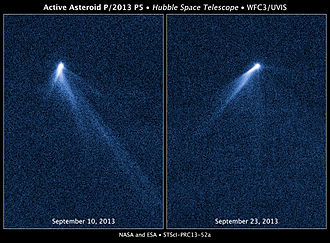 Comet 311P/PanSTARRS imaged by the Hubble Space Telescope on 10–23 September 2013 | |
| Discovery [1] | |
|---|---|
| Discovered by | Bryce T. Bolin |
| Discovery site | Haleakala Observatory (Pan-STARRS) |
| Discovery date | 27 August 2013 |
| Designations | |
| P/2013 P5 | |
| Orbital characteristics [2] | |
| Epoch | 29 April 2017 (JD 2457872.5) |
| Observation arc | 20.29 years |
| Earliest precovery date | 17 January 2005 |
| Number of observations | 272 |
| Aphelion | 2.442 AU |
| Perihelion | 1.936 AU |
| Semi-major axis | 2.189 AU |
| Eccentricity | 0.11567 |
| Orbital period | 3.238 years |
| Avg. orbital speed | 0.304°/d |
| Inclination | 4.966° |
| 279.26° | |
| Argument of periapsis | 143.99° |
| Mean anomaly | 337.88° |
| Last perihelion | 1 January 2024 |
| Next perihelion | 30 March 2027 |
| TJupiter | 3.661 |
| Earth MOID | 0.949 AU |
| Jupiter MOID | 2.818 AU |
| Physical characteristics | |
Mean diameter | ~0.48 km (0.30 mi) [3] |
Mean density | 3.3±0.2 g/cm3 [3] |
| ~0.240 m/s [3] | |
| ≥ 5.4 hours [4] | |
| 0.29±0.09 [5] | |
| Comet total magnitude (M1) | 18.98±0.10 [5] |
311P/PanSTARRS, also known as P/2013 P5 (PanSTARRS), is an active asteroid and Encke-type comet discovered by Bryce T. Bolin using the Pan-STARRS telescope on 27 August 2013. [1] [6] Observations made by the Hubble Space Telescope revealed that it had six comet-like tails. [7] The tails are suspected to be streams of material ejected by the asteroid as a result of a rubble pile asteroid spinning fast enough to remove material from it. [3] This is similar to 331P/Gibbs, which was found to be a quickly-spinning rubble pile as well.
Contents
Three-dimensional models constructed by Jessica Agarwal of the Max Planck Institute for Solar System Research in Lindau, Germany, showed that the tails could have formed by a series of periodic impulsive dust-ejection events, [a] radiation pressure from the Sun then stretched the dust into streams. [7]
Precovery images from the Sloan Digital Sky Survey from 2005 were found, showing negligible cometary activity in 2005.[ citation needed ]




